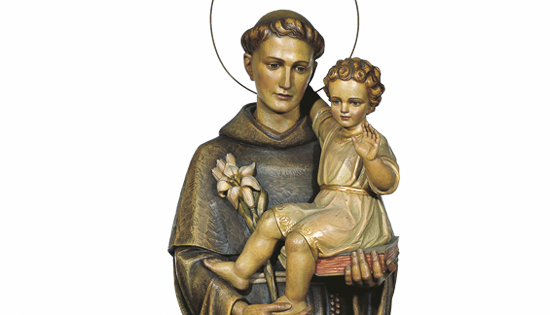Anthony was buried in Padua, on Tuesday, the 17th of June, 1231, in the church of Santa Maria Mater Domini. His body was probably not buried underground, but placed on a suspended marble ark-tomb so that the numerous devotees and faithful could see and touch it.
For various reasons over the centuries his tomb was opened and his mortal remains were moved on three separate occasions:
The Recognition and Transposition of 1263
The most important recognition and transposition took place on the 8th of April, 1263, when his body was transferred to the newly constructed Basilica built in his honour. Bonaventure of Bagnoregio, Minister General of the Franciscan order (himself to be canonized after his death) presided over the ceremony.
While examining the remains before placing them in a new wooden chest, Bonaventure realized that the Saint’s tongue had remained incorrupt. He therefore exclaimed: “O blessed tongue, which has always blessed God and caused others to bless Him, now it appears evident how great were your merits before God.”
The Transposition of 1310
Another transposition took place on the 14th of June 1310, when the sacred remains were solemnly transferred in a new chapel dedicated to the Saint, the Chapel of St. Anthony, located on the left side of the nave. This is where the Saint’s Tomb is to be found to this day. On the 14th of February 1350, Cardinal Guido de Boulogne came to Padua to fulfill a vow to the Saint (he had been cured of the Black Plague) and to donate a precious reliquary, in which the jaw of the Saint was placed.
The Scientific Examination and Exposition of 1981
A major scientific examination on the mortal remains of the Saint were begun on the 6th of January 1981, on the occasion of the 750th anniversary of his death. A religious commission and a technical-scientific committee, both appointed by the Holy See, supervised the opening of the Tomb and examined its contents. After removing the green marble slab on the side, they found a large chest of fir-tree wood, wrapped with cloths. It contained a smaller chest in fir-tree, in which were various bundles arranged in three compartments. The bundles were wrapped in precious cloths and came with some written indications. The three compartments contained:
- The skeleton, except for the jawbone, the left fore-arm and other minor parts (these have been kept for centuries in other reliquaries).
- The habit.
- The ‘mass corporis’, that is, the ashes.
Saint Anthony’s mortal remains were then reassembled in a crystal urn and exposed, from the evening of January 31 to the evening of Sunday March 1, 1981 (a total of 29 days), to the veneration of the faithful, who flocked to see them in huge numbers: more than 650,000 people. After the exposition the crystal urn was placed in an oak chest and returned to its former, traditional location in the Chapel of St. Anthony.
Some of these objects, in particular the Habit and the Saint’s Vocal Apparatus, are permanently exposed in the Chapel of Relics.


